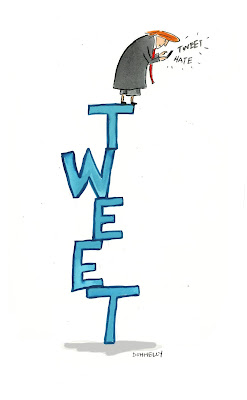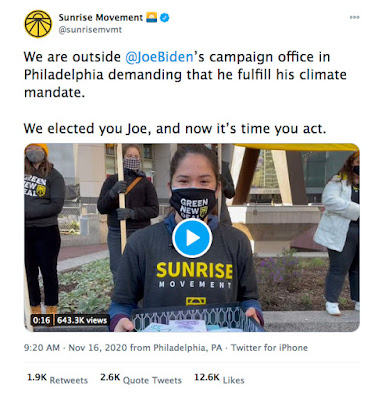 by Mike Rhode
by Mike Rhode
Dick Wright of
The Providence Journal-Bulletin was the 1983
Pulitzer Prize Finalist in Editorial Cartooning. As Dave Astor has written, “Wright
worked for the [San Diego]
Union-Tribune
… (starting in 1976) and later joined
The
Providence (R.I.) Journal, the
Nashville
(Tenn.) Banner, and
The Columbus
(Ohio) Dispatch. Currently [2005], he’s affiliated with the
Gwinnett Daily Post of Lawrenceville,
Ga. He was syndicated by Tribune Media Services, then Copley News Service, and
finally for several years in the early 2000s by Daryl Cagle. His work was
collected in the book
If He Only Had a
Brain... in 1998. The
Cartoon
Art Museum in San Francisco “houses over 300 political cartoons illustrated
by famed cartoonist Dick Wright in the mid-1990s.”
He
retired from editorial cartooning in 2005, around the same time he was
profiled by the
Washington
Times. Wright has
recently returned to editorial cartooning.
What type of comic work or
cartooning do you do?
I draw editorial cartoons.
How do you do it? Traditional
pen and ink, computer or a combination?
I use a brush, pen and India ink.
When (within a decade is fine)
and where were you born?
I was born in 1944.
Why are you in the Washington area
now? What neighborhood or area do you
live in?
I live in Warrenton, Virginia.
What is your training and/or education
in cartooning?
I am self-taught. I went to Long Beach State University and I majored
in finance.
Who are your influences?
Mad magazine, and especially Mort Drucker. Also, Walt Disney.
If you could, what in your career
would you do-over or change?
I think I would do more local cartoons.
What work are you best-known
for?
I can't think of a single piece of work. In general probably my
caricatures.
What work are you most proud of?
Well, when I started I was pretty rough. I guess that given where I
started I am most proud of what I developed into. My work is a far cry from
when I started. I had some help along the way. Mort Drucker was a great
encouragement to me as well as Karl Hubenthal in Los Angeles.
What would you like to do or
work on in the future?
I am content to do cartoons about Virginia at this point in my career.
What do you do when you're in a
rut or have writer's block?
I used to keep a file of "ideas" that I used to trigger new
ideas. If you worked at it long enough something would come.
What do you think will be the
future of your field?
I think that the future in cartooning is in online venues.
What local cons do you attend?
I don't attend any.
What's your favorite thing about
DC?
I worked in DC for Scripps-Howard Newspapers. I got to know DC a bit. I
guess being in the middle of the action was my favorite thing. I ran into many
people that were real players. I enjoyed that
Least favorite?
Traffic.
What monument or museum do you
like to take visitors to?
The Smithsonian.
How about a favorite local
restaurant?
I love Mexican food just about anywhere.
Do you have a website or blog?
How has the COVID-19 outbreak
affected you, personally and professionally?
I work from home anyway so it really hasn't impacted me much.
Can you tell us a bit about being a church
pastor and your faith?
I grew up in church. I had a very powerful experience with God at about
the age of thirteen. From that time forward, I was deeply engaged in church and
was very focused on spiritual things. On my own I began to read the Bible every
evening before going to sleep. In reading the Bible, I learned a lot about God
and it changed me. Even as a young teen, I became very interested in someday
serving the Lord as a pastor. My parents were middle class. We struggled
financially even as my dad worked two and three jobs as far back as I can
remember. When it came time for me to go to college, I did not have you the
heart to ask for help in going to college. I was interested in going to a bible
college to become a pastor. Instead, I attended Junior College with no
particular direction. I dropped out and got a job as a draftsman because I
could draw. In those days we actually drew by hand the things we were building.
I advanced quickly and moved up to a junior designer at the Jet Propulsion Lab
in Pasadena, California. I became interested in engineering.

By then I was married with two little girls. I wanted to become a
senior designer, but you had to be degreed. So I went to Long Beach State
studying engineering and worked full time. While I was at Long Beach State I
began to draw cartoons for the university newspaper, the 49'er. I did this a couple of years and finally I went to some
local newspaper editors and asked them what they thought of my work. They were
very encouraging and began to print a few. This changed my whole direction. I
began to consider changing my career goal from engineering to cartooning. I
spent about two years contacting newspapers looking for a job. Finally, I was
hired at the San Diego Union as their
back-up cartoonist and illustrator and I was on my way. It didn't take long for
my editorial cartoons to be used more and more and I became the lead
cartoonist. I was in San Diego for about eighteen months and then moved to the Providence Journal and that is where my
career took off. I was focused on being as good as I could be. I would get up
at about four in the morning and read the paper cover to cover. My intent was
to know what was going on so my cartoons had substance. I worked at it. I
became syndicated and my list of papers grew to about 420. This was a lot,
since at that time there were only about 1700 dailies in the country.

This went on for years, but I never forgot the early experience I had
with God and my very distinct call to be a pastor. As my list of papers grew I
reached my limit. I began to struggle to keep the numbers up and had to work
harder just to stay even. I began to realize that there was no way I could
sustain what I had been doing for years and I became discouraged. I began to
question what I was doing, and for what? At this time I began to think about
becoming a pastor and fulfill that early calling. I was 52 at the time. I began
to seek out what was necessary to become a pastor. I had a friend who was a
pastor who told me that in Virginia all you needed to become a pastor was to be
ordained by a church and I could become a pastor. His church ordained me as I
had 30 years’ experience leading and teaching the Word. Within a month I had
gathered together a group of 21 people and we started a church and I was the
pastor. In 12 weeks the church grew to 100 attenders. Three years later we
completed a new church building. In five years, my church had grown to more
than 400. I retired and then came out of retirement to help another small
church get established. I am currently the assistant pastor at that church now.
You mentioned Mort Drucker who just passed
away this month, after a long life. Do you have any specific stories or
anecdotes about knowing him?
When I was trying to get into
cartooning, I wrote Mort a letter with some of my work to
Mad magazine. I received a letter back from him. He was gracious and
encouraging. He offered advice about cartooning that was very helpful. One of
the things he told me was that every assignment I get and send off should be
better than the last job I did. He said this was the way to get better. He said
that when you plateau and level off, keep working at doing better than your
last job. He said this is how he improved. Mort was a very kind and gracious
man. Many years later, when I was the cartoonist at the
Providence Journal, I was involved is getting the program set for
an editorial cartooning convention. I contacted
Mad and talked to the editor and invited all the cartoonist to the convention
in Newport. Mort and Jack Davis showed up along with some others. What a
thrill! I have a photo of Mort and myself taken at the mansion where we were
hosting the convention. He was so gracious and kind to me. What a great
cartoonist, a great man. I miss him.
4/23/2020: Updated with links to Wright's Facebook page, thanks to
DD Degg of the Daily Cartoonist.



























